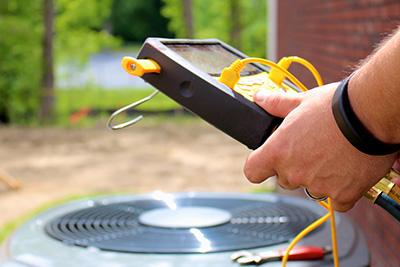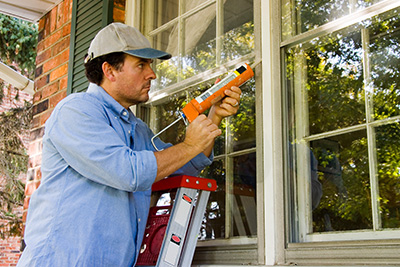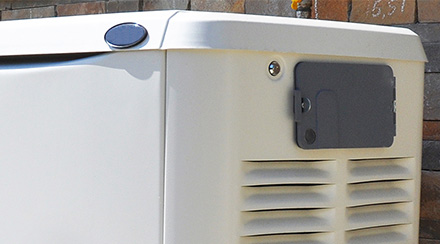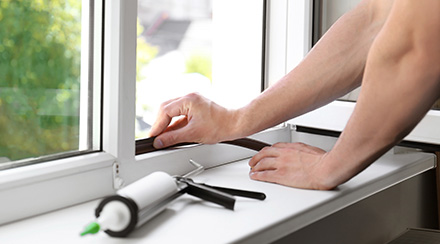Tips for Lowering Your Electricity Bill in Summer
For all the fun in the sun summer has to offer, its soaring temperatures tend to bring along an unwelcome guest: rising energy costs. Luckily, incorporating a few simple habits into your day can help lower your usage and keep your energy bills under control. We're also sharing quick and in-depth tips on how to make small home improvements that take the heat off of your AC.

Energy-Saving Habits for Summer
- Check your thermostat settings. The key to saving energy with your thermostat is in setting the temperature a little higher when it won’t affect your comfort level. Try turning it up two or three degrees higher between 2 and 7 p.m., and turn on a fan to feel cooler.
- Save energy while you're away. If no one will be home for more than four hours, turn your thermostat up a few degrees while you’re out.
- Make sure your HVAC system is set to “Auto”, not “On”. This ensures it doesn’t run constantly.
- Change your air filters regularly so your HVAC system can run at peak efficiency.
- Keep the sun out. Thermal drapes and blackout curtains can block out heat and keep the air inside your home cool.
- Set your ceiling fan blades to turn counterclockwise. This pushes air down and creates a nice, cool breeze. Look for a switch on the base of the fan to adjust the spin direction.
- Wait until the sun sets to use big appliances like washing machines and dishwashers. Only use the dishwasher when you have a full load.
- Reduce the number of meals you prepare on the stove or in the oven as they generate lots of heat. Instead, pop something in the microwave or toaster oven or, better yet, take advantage of the summer season by grilling outdoors.
Prepare for Summer With These Energy Efficiency Tips
You can also keep your energy usage and costs under control with some easy prep work and home maintenance tasks.
- Seal doors and windows to keep the heat out. You can save up to 10% on total energy costs by replacing the weather stripping around exterior door frames and windows.
- Swap out incandescent bulbs for LED lighting. LED bulbs are more energy efficient and last much longer.
- Have your AC unit inspected by a reputable HVAC company. They'll be able to tell you if your unit could use a tune-up, boosting energy efficiency and making sure your system can withstand the season.
- Know your energy plan. Electricity and natural gas prices tend to increase in summer months as demand rises. Price fluctuation mostly affects customers on a variable-price energy plan. If you're on a variable-price plan, consider locking in a fixed-price option to stabilize your energy costs. If you're an NRG customer, you can access your current plan and make sure you're on the right plan for your needs by logging into your Online Account Manager. Not an NRG customer? View our offers.
- Upgrade your home with a Google Nest programmable thermostat for up to 12% savings on cooling costs. Smart thermostats can automatically set the temperature higher when you're away. If you're an NRG customer, you can even control your Nest thermostat from your My NRG app.
- Have backup power prepared. Backup power sources can keep your home powered in case of a power outage.
- Consider solar energy. Solar energy is becoming more accessible for both homeowners and renters. If you own your home, solar energy can be a great option to save money on your electric bill, and depending on your state, get tax credits and sell some energy back to the power grid. If solar panels aren't in the cards, look into contributing to local community solar programs for an opportunity to save on your bill.
Managing Higher Summer Bills
Summer energy bills can be higher for several reasons, but the biggest culprit is usually increased HVAC use. Heating and cooling costs account for about 42% of your home energy bill, so cranking down the temperature will almost certainly lead to higher bills in the summer. It's even more likely if you haven't taken steps to make your home more energy efficient. Here are some other factors that can play a role:
- Energy costs are rising nationwide. The U.S Energy Information Administration predicts that home electricity prices will rise nearly 5% compared to last summer, while natural gas prices will increase by 59%. Consumers on variable-rate plans will be most affected by this as their energy rate can change month to month.
- It's hot out there! Record high temperatures across the U.S. mean demand is sky high. As everyone uses more energy to stay comfortable, energy generators rely on more expensive resources to meet demand.
- Over-adjusting your thermostat does more harm than good. Dropping your thermostat setting 10 degrees on a hot summer afternoon won't cool you down any faster. It just means your AC will run longer, use more energy, cost you more money and wear out your unit.
How to Keep Your House Cool Without Overworking Your AC
If you count on air conditioning at home for relief from scorching summer temperatures, you’ve probably noticed that your electricity bills tend to be higher during the hottest months. Even the most energy-efficient air conditioners draw more electricity than most other appliances in a typical home. To keep your summertime electricity bills as low as possible, it helps to manage your air conditioner use carefully, as well as to seal and insulate your home to block out the heat.
These summer energy saving tips cover the most effective strategies for reducing your electricity costs without sacrificing comfort.

Maintaining Your Home Cooling Equipment
Inefficient or poorly maintained home cooling equipment will cost you in the long run, no matter what else you’re doing to reduce your summertime energy costs.
For air conditioner and furnace efficiency, annual maintenance is key. Central air conditioners should be serviced by a licensed professional at least once per year, ideally before the start of summer. An air conditioner tune-up should include a full parts inspection, lubrication and coolant top-off, if necessary. It also provides an opportunity to identify and repair small problems before they turn into big ones. In addition to this annual maintenance, you should be sure to change your system’s air filters on schedule, as dirty filters can be a significant drag on energy efficiency.
A central air unit should last between 15 and 20 years, but its efficiency will decline over time. As your system nears the end of its lifespan, start making a plan for replacement and discussing the condition of your system with your HVAC technician during tune-ups. This is also a time to pay close attention to your electricity bills, because higher-than-usual energy costs could be a sign that your air conditioner is failing.
Other types of home cooling equipment have maintenance and replacement intervals, too. Window air conditioners don’t last quite as long as central air units, requiring replacement closer to every 10 years. They are, however, lower maintenance – a thorough cleaning of the filter and exterior at the beginning of summer should keep it in good working order all season long.
Evaporative coolers, also called swamp coolers, should be serviced annually by a professional to clean the unit, lubricate parts and check for signs of wear. Evaporative cooler pads should be replaced as recommended by the manufacturer; this interval varies based on the material the pads are made of.
Geothermal systems should be maintained similarly to central air units: annual tune-ups from licensed professionals, coupled with routine replacement of air filters. But they tend to last significantly longer, with most geothermal heat pumps lasting more than 20 years and underground piping designed to last even longer.
Using Your Thermostat Efficiently
Now that your home cooling equipment is in good working condition, it’s time to make sure you’re not using it more than you have to. That begins with efforts to help your body feel cool and comfortable without using air conditioning. Dress in light, breathable clothing and use fans to help stay cool in occupied rooms. Remember to turn off the fans when the last person leaves, though – fans only cool people, not air.
The U.S. Department of Energy recommends 78 degrees Fahrenheit as an ideal thermostat setting for summer when your home is occupied. But if you feel the need to at least periodically set the temperature lower to feel comfortable, you can still save energy by installing a programmable or smart thermostat.
Programmable thermostats allow you to set heating and cooling schedules, and are good for households where occupants mostly follow set routines. You can set the temperature higher during the hours when the house is empty, and lower for the hours when people are home. A smart thermostat is even more sophisticated, allowing control from virtually anywhere with a smartphone or tablet. You can set schedules using your handheld device, and if your plans ever change and you want to override the program, you can do it with a few taps of your phone.

Air Sealing Your Home
If you have air leaks in your home, some of the air that you’re paying to chill will slip right back outside. To prevent this, it’s important to periodically inspect your home for drafts and perform air sealing repairs where needed.
The most effective method is to schedule a professional home energy audit. During this service, technicians will use airflow equipment and infrared imaging to pinpoint the areas where air is leaking out of (or into) your home. You can then repair these areas by replacing ineffective weather stripping on doors and windows, closing gaps with caulk or spray foam, or insulating weak spots like those around electrical outlets or recessed lighting. Our guide to weatherizing your home for summer offers advice for making your home more energy-efficient, especially when it comes to your cooling equipment.
If you don’t do an energy audit, you can still search for air leaks on your own. Hardware stores sell draft detection devices that emit a smooth stream of odorless smoke. As you slowly move the detector through your home, disruptions of the stream of smoke can help you identify where the air leaks are coming from.
Door and window weather stripping is one of the most common sources of air leaks. Once a year, inspect these seals to ensure that they’re still tight and springy, not cracked and brittle. If you’re not sure, try closing a dollar bill in the door or window and gently pulling it out. If it pulls through easily, it’s time for replacement. Stopping door drafts and window leaks is a simple fix with weather stripping repair kits, found at most hardware stores.
Blocking Out Heat
With your cooling equipment maintained, your thermostat set and your home sealed off from air leaks, the last step is to eliminate unwanted sources of heat.
Windows are one of the biggest culprits here, especially south-facing and west-facing windows in the late afternoon. The hot sunlight streaming into your house is fighting against your cooling system, forcing it to work harder and driving up your energy bill. Heavy drapes or blackout curtains are great for shutting out hot sunlight, but if you would like to let a little light in, cellular blinds help to bring in sunlight while offering a buffer from the heat.
If you’re using old-fashioned incandescent light bulbs throughout your home, that’s a double whammy on your electric bill. Incandescents consume far more electricity than modern LED bulbs, and they also put off much more heat. It’s best to use LEDs wherever possible.
Using your oven and stove can also release heat into your home, so you should try to use them as little as possible on hot days, especially during the warmest hours. During peak temperatures, try to rely more on microwaves, small countertop cooking appliances and outdoor grills. If you do plan on using your oven and stove, consider doing it later in the evening, after the heat of the day has passed. Be sure to use your hood vent fan, if you have one, to help remove warm air.
Running the dishwasher, washing machine and dryer at night is another good practice. These appliances give off heat, which will be easier for your cooling equipment to remove at night. And if you pay a variable rate for electricity, you might also find that the cost of running your major appliances is lower at night.
Energy Conservation Pays Off in More Ways Than One
Your efforts to save energy in the summer can make a real difference in the size of your energy bills, but that’s not all it can do. Conserving energy at home helps reduce greenhouse gas emissions, slowing the advance of climate change and improving air quality.
When energy demand peaks during the hottest days of the year, every little bit helps the environment, and can help you save energy.
Additional Tools and Resources
In addition to creating energy-saving habits and an energy-efficient home, managing your energy usage and plan will help you make sure your needs are being met. Use our tools to help you get more insight into your home energy, and make sure to keep your utility contact on hand in case of emergencies.
- Online account management: Access information about your NRG account, such as pricing, usage history, plan expiration date, rewards details, and more. Log in or register.
- My NRG app: Managing your account is quick and easy with the My NRG app. View plan details, track rewards and monitor your usage history with the My NRG app.
- Outage contact: You’ll contact your local utility in the event of an outage, so it’s helpful to keep their contact information on hand. Find your utility information.
- Check your inbox: Make sure you’re reading our monthly newsletter and weekly summary email* for usage comparisons, energy-saving tips and more.
*In select markets.
Looking for Something Specific?
Select a category to find resources for topics that interest you.
Select Category

Related Articles:

What to Do Before, During and After Power Outages
With a little knowledge and preparation, you can protect yourself, your home and your belongings during power outages of any duration.
Read Article
How to Choose a Generator for Your Home
Power outages can be miserable, but with the right generator, you can keep your family safe and comfortable until power is restored. Learn how to choose the best generator for your home.
Read Article
Weatherize Your Home for Summer
The extreme heat of summer can really do a number on your energy bills. But if you’re able to invest a little time and money into weatherizing to keep your home cool, you can help yourself and your family remain comfortable at home while still saving energy.
Read ArticleMost Popular Articles

Energy Plans to Fit Your Lifestyle
NRG offers electricity and natural gas plans with perks like cash back, travel rewards and more, so you can find a plan that fits your home and family.
Tips for Lowering Your Electricity Bill in Summer
For all the fun in the sun summer has to offer, its soaring temperatures tend to bring along an unwelcome guest: rising energy costs. Luckily, incorporating a few simple habits into your day can help lower your usage and keep your energy bills under control. We're also sharing quick and in-depth tips on how to make small home improvements that take the heat off of your AC.
Energy-Saving Habits for Summer
- Check your thermostat settings. The key to saving energy with your thermostat is in setting the temperature a little higher when it won’t affect your comfort level. Try turning it up two or three degrees higher between 2 and 7 p.m., and turn on a fan to feel cooler.
- Save energy while you're away. If no one will be home for more than four hours, turn your thermostat up a few degrees while you’re out.
- Make sure your HVAC system is set to “Auto”, not “On”. This ensures it doesn’t run constantly.
- Change your air filters regularly so your HVAC system can run at peak efficiency.
- Keep the sun out. Thermal drapes and blackout curtains can block out heat and keep the air inside your home cool.
- Set your ceiling fan blades to turn counterclockwise. This pushes air down and creates a nice, cool breeze. Look for a switch on the base of the fan to adjust the spin direction.
- Wait until the sun sets to use big appliances like washing machines and dishwashers. Only use the dishwasher when you have a full load.
- Reduce the number of meals you prepare on the stove or in the oven as they generate lots of heat. Instead, pop something in the microwave or toaster oven or, better yet, take advantage of the summer season by grilling outdoors.
Prepare for Summer With These Energy Efficiency Tips
You can also keep your energy usage and costs under control with some easy prep work and home maintenance tasks.
- Seal doors and windows to keep the heat out. You can save up to 10% on total energy costs by replacing the weather stripping around exterior door frames and windows.
- Swap out incandescent bulbs for LED lighting. LED bulbs are more energy efficient and last much longer.
- Have your AC unit inspected by a reputable HVAC company. They'll be able to tell you if your unit could use a tune-up, boosting energy efficiency and making sure your system can withstand the season.
- Know your energy plan. Electricity and natural gas prices tend to increase in summer months as demand rises. Price fluctuation mostly affects customers on a variable-price energy plan. If you're on a variable-price plan, consider locking in a fixed-price option to stabilize your energy costs. If you're an NRG customer, you can access your current plan and make sure you're on the right plan for your needs by logging into your Online Account Manager. Not an NRG customer? View our offers.
- Upgrade your home with a Google Nest programmable thermostat for up to 12% savings on cooling costs. Smart thermostats can automatically set the temperature higher when you're away. If you're an NRG customer, you can even control your Nest thermostat from your My NRG app.
- Have backup power prepared. Backup power sources can keep your home powered in case of a power outage.
- Consider solar energy. Solar energy is becoming more accessible for both homeowners and renters. If you own your home, solar energy can be a great option to save money on your electric bill, and depending on your state, get tax credits and sell some energy back to the power grid. If solar panels aren't in the cards, look into contributing to local community solar programs for an opportunity to save on your bill.
Managing Higher Summer Bills
Summer energy bills can be higher for several reasons, but the biggest culprit is usually increased HVAC use. Heating and cooling costs account for about 42% of your home energy bill, so cranking down the temperature will almost certainly lead to higher bills in the summer. It's even more likely if you haven't taken steps to make your home more energy efficient. Here are some other factors that can play a role:
- Energy costs are rising nationwide. The U.S Energy Information Administration predicts that home electricity prices will rise nearly 5% compared to last summer, while natural gas prices will increase by 59%. Consumers on variable-rate plans will be most affected by this as their energy rate can change month to month.
- It's hot out there! Record high temperatures across the U.S. mean demand is sky high. As everyone uses more energy to stay comfortable, energy generators rely on more expensive resources to meet demand.
- Over-adjusting your thermostat does more harm than good. Dropping your thermostat setting 10 degrees on a hot summer afternoon won't cool you down any faster. It just means your AC will run longer, use more energy, cost you more money and wear out your unit.
How to Keep Your House Cool Without Overworking Your AC
If you count on air conditioning at home for relief from scorching summer temperatures, you’ve probably noticed that your electricity bills tend to be higher during the hottest months. Even the most energy-efficient air conditioners draw more electricity than most other appliances in a typical home. To keep your summertime electricity bills as low as possible, it helps to manage your air conditioner use carefully, as well as to seal and insulate your home to block out the heat.
These summer energy saving tips cover the most effective strategies for reducing your electricity costs without sacrificing comfort.
Maintaining Your Home Cooling Equipment
Inefficient or poorly maintained home cooling equipment will cost you in the long run, no matter what else you’re doing to reduce your summertime energy costs.
For air conditioner and furnace efficiency, annual maintenance is key. Central air conditioners should be serviced by a licensed professional at least once per year, ideally before the start of summer. An air conditioner tune-up should include a full parts inspection, lubrication and coolant top-off, if necessary. It also provides an opportunity to identify and repair small problems before they turn into big ones. In addition to this annual maintenance, you should be sure to change your system’s air filters on schedule, as dirty filters can be a significant drag on energy efficiency.
A central air unit should last between 15 and 20 years, but its efficiency will decline over time. As your system nears the end of its lifespan, start making a plan for replacement and discussing the condition of your system with your HVAC technician during tune-ups. This is also a time to pay close attention to your electricity bills, because higher-than-usual energy costs could be a sign that your air conditioner is failing.
Other types of home cooling equipment have maintenance and replacement intervals, too. Window air conditioners don’t last quite as long as central air units, requiring replacement closer to every 10 years. They are, however, lower maintenance – a thorough cleaning of the filter and exterior at the beginning of summer should keep it in good working order all season long.
Evaporative coolers, also called swamp coolers, should be serviced annually by a professional to clean the unit, lubricate parts and check for signs of wear. Evaporative cooler pads should be replaced as recommended by the manufacturer; this interval varies based on the material the pads are made of.
Geothermal systems should be maintained similarly to central air units: annual tune-ups from licensed professionals, coupled with routine replacement of air filters. But they tend to last significantly longer, with most geothermal heat pumps lasting more than 20 years and underground piping designed to last even longer.
Using Your Thermostat Efficiently
Now that your home cooling equipment is in good working condition, it’s time to make sure you’re not using it more than you have to. That begins with efforts to help your body feel cool and comfortable without using air conditioning. Dress in light, breathable clothing and use fans to help stay cool in occupied rooms. Remember to turn off the fans when the last person leaves, though – fans only cool people, not air.
The U.S. Department of Energy recommends 78 degrees Fahrenheit as an ideal thermostat setting for summer when your home is occupied. But if you feel the need to at least periodically set the temperature lower to feel comfortable, you can still save energy by installing a programmable or smart thermostat.
Programmable thermostats allow you to set heating and cooling schedules, and are good for households where occupants mostly follow set routines. You can set the temperature higher during the hours when the house is empty, and lower for the hours when people are home. A smart thermostat is even more sophisticated, allowing control from virtually anywhere with a smartphone or tablet. You can set schedules using your handheld device, and if your plans ever change and you want to override the program, you can do it with a few taps of your phone.
Air Sealing Your Home
If you have air leaks in your home, some of the air that you’re paying to chill will slip right back outside. To prevent this, it’s important to periodically inspect your home for drafts and perform air sealing repairs where needed.
The most effective method is to schedule a professional home energy audit. During this service, technicians will use airflow equipment and infrared imaging to pinpoint the areas where air is leaking out of (or into) your home. You can then repair these areas by replacing ineffective weather stripping on doors and windows, closing gaps with caulk or spray foam, or insulating weak spots like those around electrical outlets or recessed lighting. Our guide to weatherizing your home for summer offers advice for making your home more energy-efficient, especially when it comes to your cooling equipment.
If you don’t do an energy audit, you can still search for air leaks on your own. Hardware stores sell draft detection devices that emit a smooth stream of odorless smoke. As you slowly move the detector through your home, disruptions of the stream of smoke can help you identify where the air leaks are coming from.
Door and window weather stripping is one of the most common sources of air leaks. Once a year, inspect these seals to ensure that they’re still tight and springy, not cracked and brittle. If you’re not sure, try closing a dollar bill in the door or window and gently pulling it out. If it pulls through easily, it’s time for replacement. Stopping door drafts and window leaks is a simple fix with weather stripping repair kits, found at most hardware stores.
Blocking Out Heat
With your cooling equipment maintained, your thermostat set and your home sealed off from air leaks, the last step is to eliminate unwanted sources of heat.
Windows are one of the biggest culprits here, especially south-facing and west-facing windows in the late afternoon. The hot sunlight streaming into your house is fighting against your cooling system, forcing it to work harder and driving up your energy bill. Heavy drapes or blackout curtains are great for shutting out hot sunlight, but if you would like to let a little light in, cellular blinds help to bring in sunlight while offering a buffer from the heat.
If you’re using old-fashioned incandescent light bulbs throughout your home, that’s a double whammy on your electric bill. Incandescents consume far more electricity than modern LED bulbs, and they also put off much more heat. It’s best to use LEDs wherever possible.
Using your oven and stove can also release heat into your home, so you should try to use them as little as possible on hot days, especially during the warmest hours. During peak temperatures, try to rely more on microwaves, small countertop cooking appliances and outdoor grills. If you do plan on using your oven and stove, consider doing it later in the evening, after the heat of the day has passed. Be sure to use your hood vent fan, if you have one, to help remove warm air.
Running the dishwasher, washing machine and dryer at night is another good practice. These appliances give off heat, which will be easier for your cooling equipment to remove at night. And if you pay a variable rate for electricity, you might also find that the cost of running your major appliances is lower at night.
Energy Conservation Pays Off in More Ways Than One
Your efforts to save energy in the summer can make a real difference in the size of your energy bills, but that’s not all it can do. Conserving energy at home helps reduce greenhouse gas emissions, slowing the advance of climate change and improving air quality.
When energy demand peaks during the hottest days of the year, every little bit helps the environment, and can help you save energy.
Additional Tools and Resources
In addition to creating energy-saving habits and an energy-efficient home, managing your energy usage and plan will help you make sure your needs are being met. Use our tools to help you get more insight into your home energy, and make sure to keep your utility contact on hand in case of emergencies.
- Online account management: Access information about your NRG account, such as pricing, usage history, plan expiration date, rewards details, and more. Log in or register.
- My NRG app: Managing your account is quick and easy with the My NRG app. View plan details, track rewards and monitor your usage history with the My NRG app.
- Outage contact: You’ll contact your local utility in the event of an outage, so it’s helpful to keep their contact information on hand. Find your utility information.
- Check your inbox: Make sure you’re reading our monthly newsletter and weekly summary email* for usage comparisons, energy-saving tips and more.
*In select markets.
Looking for Something Specific?
Select a category to find resources for topics that interest you.
Select Category

Related Articles:

What to Do Before, During and After Power Outages
With a little knowledge and preparation, you can protect yourself, your home and your belongings during power outages of any duration.
Read Article
How to Choose a Generator for Your Home
Power outages can be miserable, but with the right generator, you can keep your family safe and comfortable until power is restored. Learn how to choose the best generator for your home.
Read Article
Weatherize Your Home for Summer
The extreme heat of summer can really do a number on your energy bills. But if you’re able to invest a little time and money into weatherizing to keep your home cool, you can help yourself and your family remain comfortable at home while still saving energy.
Read ArticleMost Popular Articles

Energy Plans to Fit Your Lifestyle
NRG offers electricity and natural gas plans with perks like cash back, travel rewards and more, so you can find a plan that fits your home and family.







